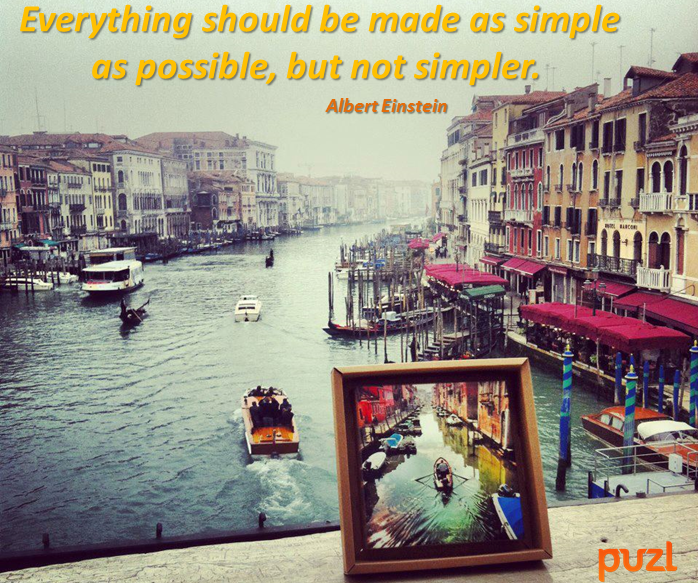4 Tips to Simplify Your Web Design
When it comes to web design - less is more. Nothing beats simplicity in making a website looking professional.An increasing part of internet users are now keener on simply designed websites with enhanced functionality rather than complex pages, cluttered with distracting ads. It's not surprising that Minimalism has recently become a popular trend amongst designers. Facing the defiance of simplistic design, they are now focused on finding the most attractive way to offer qualitative content in the least complicated manner.

If you need a little more to realize the advantages of simplifying your website design, keep this in mind:
- Simple design is less cluttered and easier to navigate
- Simple design loads faster
- Simple design is easier to manage and avoids confusion
- When design is simplified, content is better highlighted and more scannable
- Simpler design is considered more superior and elegant
- The simpler the design is, the better users experience is
- Simple design performs better across different devices
Feeling empowered to start simplifying your website? Follow these 4 tips:
1. Keep it clean and stylishYou will be amazed how many websites fail sticking to this rule. Prevent your webpages from being one of them by considering the following:
- Keep focus ed on the essentials
Pay attention to the essential elements and scrap the non-important stuff. Make sure that the key functions are not mixed up with a variety of features that make your website clumsy and over-complicated. Avoid random links, unnecessary blog post details, unorganized content or inappropriate ads. For those entrusting website builders when creating their business webpages - some platforms such as Puzl allow to build ads-free websites keeping content clear of advertising banners. This is a great move to avoid the undesirable distractors for the prospects and keep your webpages professional.
- Get into the mindset of your visitors
Bring to visitors attention directly what they are looking for. Having to scroll down to find content, is equal to a non-satisfactory experience for your users. Most prospects prefer to find the offer straight away. Scrolling down because of insignificant content is sure irritating. Your ultimate goal is to highlight the quality and relevant information so it appears easily visible and readable to the viewers.
- Ensure that the added value content is properly located above the fold
Practice has proved that a major part of users spend most of their time above the fold (what shows up on the screen without scrolling down) of the web pages they visit. Therefore, the best you can do to enhance the effectiveness of your website is to diminish the scrolling on one page. A helpful tip when having a logo and a navigation menu at the top of your site is to simply shrink the heights of the header. This will help you keep the main elements and call-to-action buttons above the fold.
2. Facilitate navigation
Have you felt confused by those websites with too many navigational menu items? Lost in the mess of elements, you don't even have an idea where to start from. Remember this when you handle your own website navigation. Simplicity enhances visitors experience and converts them into customers. On top, simplifying your navigation is SEO friendly and reflects on the higher ranking of your webpages.
Discover some helpful tips on simplifying your navigation :
- Consider the placement of the navigation buttons
- Label your navigation buttons
- Implement a single main navigation menu
- Ensure that your navigation goes consistent throughout the site
- Embed sub-navigation for individual sections to facilitate your main navigation
- Cut the pages in your main navigation menu
3. Stick to Pareto Rule
Here comes the Pareto principle also known as the 80-20 rule. As per Pareto roughly 80% of the effects come from 20% of the causes. Pay attention to two main points:
- F ocus on displaying only the 20% of site elements, delivering 80% of that usefulness
Making a parallel with web design, ask yourself the following question: What represents approximately 20% of your site content that will provide 80% of value to your readers? Only after realizing the huge difference between self-promotion and sharing value, should you know how to keep the right balance and make promotional elements work for you by sharing added value for your prospects in the meantime.
- If you want to make something stand out , take other things away
The bottom line is: simplify your website by cutting down distractions to better emphasize products and services. Instead of wasting efforts on all elements, extract those 20% (could be copy, product photos, testimonials, social media proof) which bring the real added value to your visitors and spotlight them amongst the non-essentials.

4. Limit t he color palette and text styling
Even if you have your website duly simplified, all your efforts will go in vain if the colors in your pages are abundant and confusingly combined. You might think that using dozen of colors will make your website more enticing, but in reality subtlety works more effectively when it comes to visual design. A simplified array of colors and fonts enables viewers better concentrate on the content rather than get distracted by the shiny tints and fussy fonts.
- Optimize the color scheme Unless the nature of your website requires it, in general it looks more professional to limit your color scheme to one primary color and one or two accent colors. An important thing to do is finding which shades of the same color fits best.
- S tick to the web-safe colors Looking great on your computer does not guarantee that they will appear the same on all computer screens and browsers. Always make sure they seem unchanged by testing with different screen resolutions and on different screen types.
- Reduce the bling Bling is fancy and attractive to the eyes but rather unprofessional and not elegant at all.
- Use fewer text styles Try to limit your font choices to two or three. That will help you achieve a stylish effect and better readability.
- Choose only colors in unison with your brand identity The psychology of colors plays a dominant role in representing your brand personality and strongly reflects on customers behavior. When defining the color scheme for your website, consider those issues: Which colors will give your customers the right impression for your brand from the very first sight? What colors will best describe your products/service? What are the colors used by competitors?
A more straightforward and simplistic approach in website design, is highly rewarding when it comes to providing satisfactory experience for your visitors. There are so many areas where a site can be simplified and refined. Just make sure that every time you update your website , it stays consistent with your brand.
It's your turn now. Which was the most effective simplification process that did the trick for your website? Share your experience. Tell us your favorite web design simplifying tips.
About the author
Copyright © . All Rights Reserved
